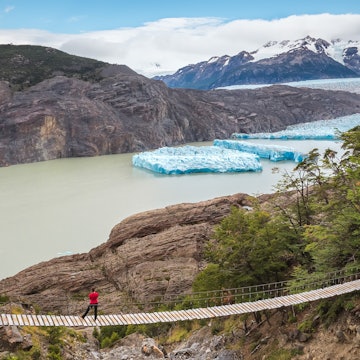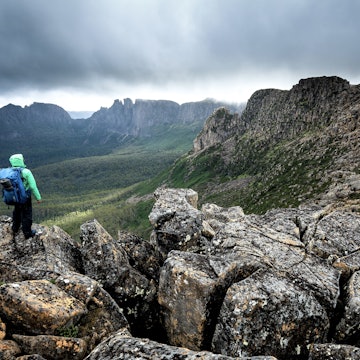

Some journeys are worth the trek © Beth Graham / Lonely Planet
I’m not exactly the rugged outdoor adventurer who seeks out adrenaline-fuelled experiences and destinations.
I’m more of the type to order room service from my luxury hotel room and maybe venture out shopping. But sometimes I like to challenge myself, so I embarked on a trip to Patagonia, where I hoped not only to explore a place unlike any I’d previously experienced but also my own comfort level.
My tolerance for discomfort was immediately tested upon reaching the part of Patagonia where I’d be staying, Torres del Paine National Park. It was a long journey which, since I was traveling from the US, involved connecting flights in Mexico and Chile, followed by a five-hour drive to the park – a full hour longer than anticipated thanks to the region’s famous winds.
Glamping in Patagonia
With that first test of my comfort level under my belt, I checked into Patagonia Camp and immediately knew I’d not only survive the week, but I’d thrive. South America’s only luxury yurt resort is glamping at its best, akin to a five-star hotel with luxury linens and an outdoor hot tub. Because sustainability is so important to me, I was excited to see the resort’s amenities are all biodegradable so that the reclaimed water can be returned to nature (so leave your shampoo and soap at home).
The bonus? My upscale “tent” had a skylight that allowed me to stare at the vast star-filled sky at night. And because there are few better ways to get comfortable than a full belly, I was glad to tuck into the camp’s gourmet meals and delightful Chilean wines which satiated much more than my appetite.
No matter where I travel, I love to engage with local guides who offer a truly authentic experience. I want to hear their personal stories and see the region through their eyes. My guide Marcy, provided by Patagonia Camp, is not only a native of the region but also incredibly passionate about her home. Her stories were told from the heart, not from a check-this-off-your-bucket-list perspective.
One day she introduced me to maté, South America’s version of an energy drink. She knew I had a fascination with gauchos (the Chilean cowboys), so she took me on a private stroll to a nearby puesto (a tiny cabin where gauchos typically shelter) and taught me the art of sharing a gourd of maté. It was a ritual that had all the coziness of a bedtime story – except that we were sitting on a dirt floor in a stark wooden shed that morning exchanging tales.
Outdoor excursions that deepen your appreciation for nature

Soon it was time to leave the comforts of camp behind and test my doggedness in the field. Following the region’s necessary mantra to dress for the seasons, we set out for the park’s Flora and Fauna Trail after we received the requisite talk about what to do if you encounter a puma.
The trail was wide open and flat, not as challenging as the W Trail, but the perfect terrain for stopping to hear Marcy’s short talks on the wildlife of the region.
She told us how to spot a condor’s nest (a little trickier than seeing the birds themselves, with their majestic 12-foot wingspan) or how guanacos (South America’s version of the llama) dig pits to bathe themselves in the sand. Marcy had great intuition as she shushed our group, pulled out her binoculars, and spotted two pumas in the distance chasing a pack of guanacos. It was a thrilling sight to see.
3 reasons to visit Argentina’s Patagonia National Park right now

For a long time, I assumed my deep dislike of cold weather meant the closest I’d get to frozen landscapes like Antarctica was by living vicariously through friends’ photos. But the (astrological) crab in me has always been drawn to water, and I couldn’t help but crave seeing icebergs and azure seas in person. It was thrilling to hear that visitors to Patagonia can embark on a Lake Gray boat excursion that weaves its way through the icebergs, not in the cold Pacific of the southern hemisphere, but from Andean glaciers.
Many of the ‘bergs on Lake Gray are the result of climate change – a soul-stirring lesson of a different sort than the inspiration Marcy usually dispensed. Rather than setting sail, I decided to approach the icebergs by foot, taking a solo stroll along Lago Grey beach so I could really take my time making memories, admiring the beauty and shooting a few selfies.
Chilean food and wine is soulful

A huge part of experiencing any culture is partaking in the food, and breaking bread together is always good for the soul. So it was very special when the chef at Patagonia Camp hosted an asado, a traditional Chilean barbecue that’s a staple of Sunday family dinners. Sheep are prevalent in the region, and they aren’t just used for wool. An asado often follows big seasonal workdays like shearing or rodeos, and starts with by roasting a lamb outdoors all day long. Eventually, the meat is served as ribs, chops, shredded or any number of ways.
Naturally, Chilean wine is part of the celebration. In this case, it was served warm as gluhwein (a kind of mulled beverage) as the camp’s employees and guides gathered around and told tales of their own family’s asado traditions, noting that “your tummy doesn’t get full, your heart does.”
I found that to be true throughout my stay in Patagonia. Even when I was pushed outside my comfort zone and challenged by the rugged landscape, this region fed me in unexpected ways. But it wasn’t just the peaks or glacial lakes or even the comfortable accommodations, that made my trip so satisfying. It was the generosity and experiences of the locals that truly enabled that conversation between person and place to truly become one of the soul.
This article was originally published on December 13, 2019.
You might also like:
When is the best time to go to Argentina?
A guide to Buenos Aires for digital nomads
Highlights of Buenos Aires















